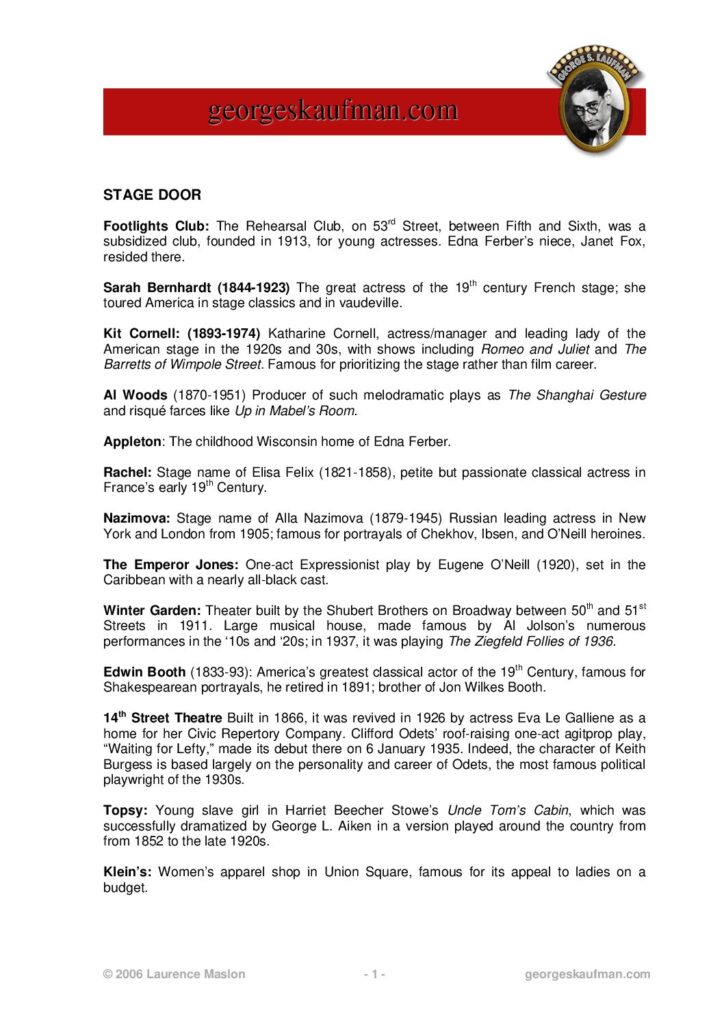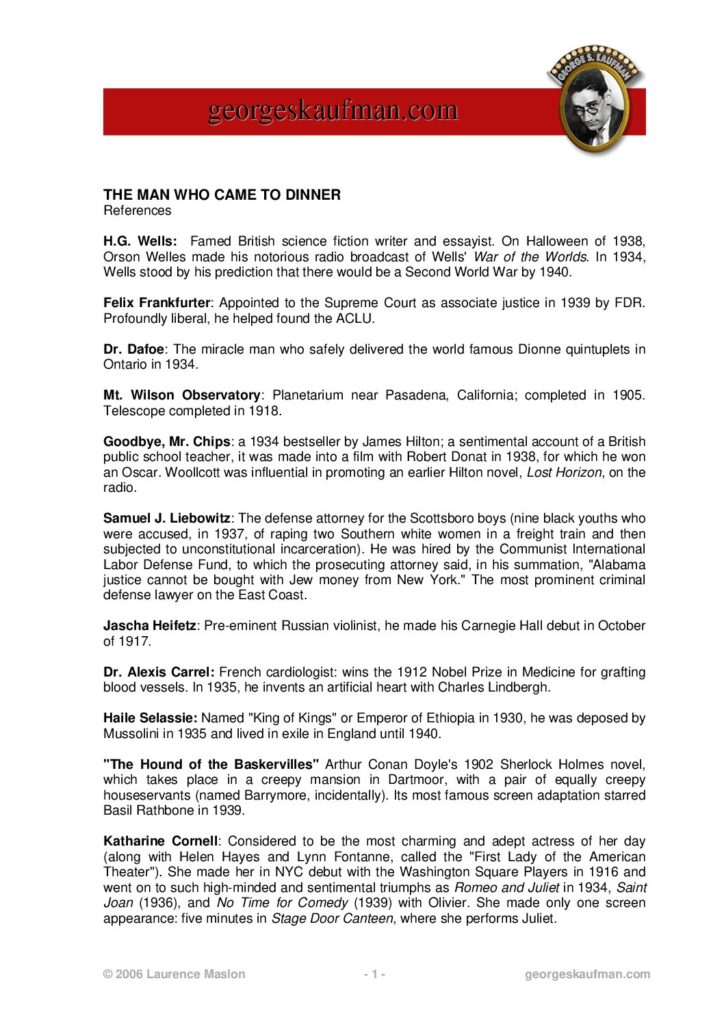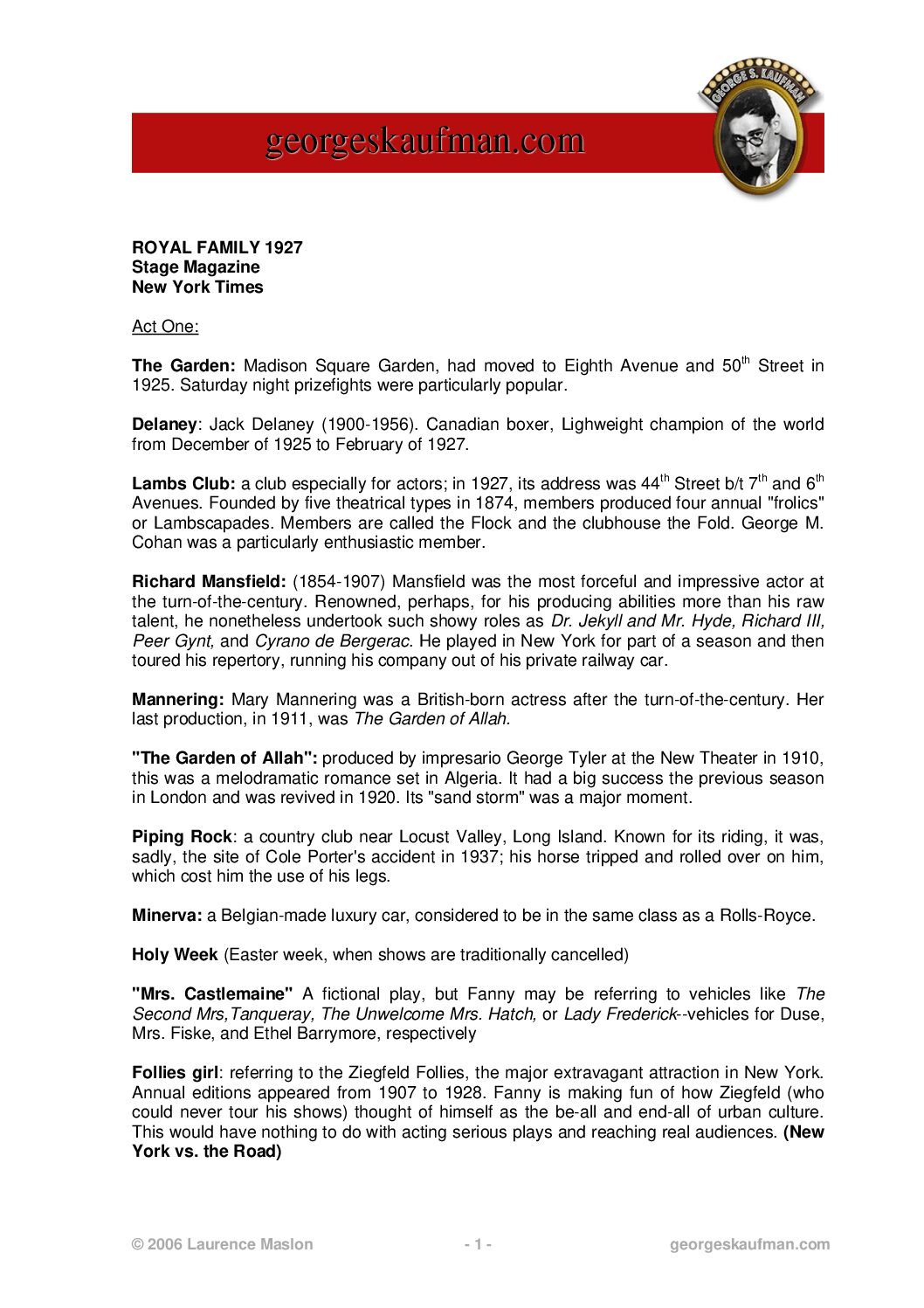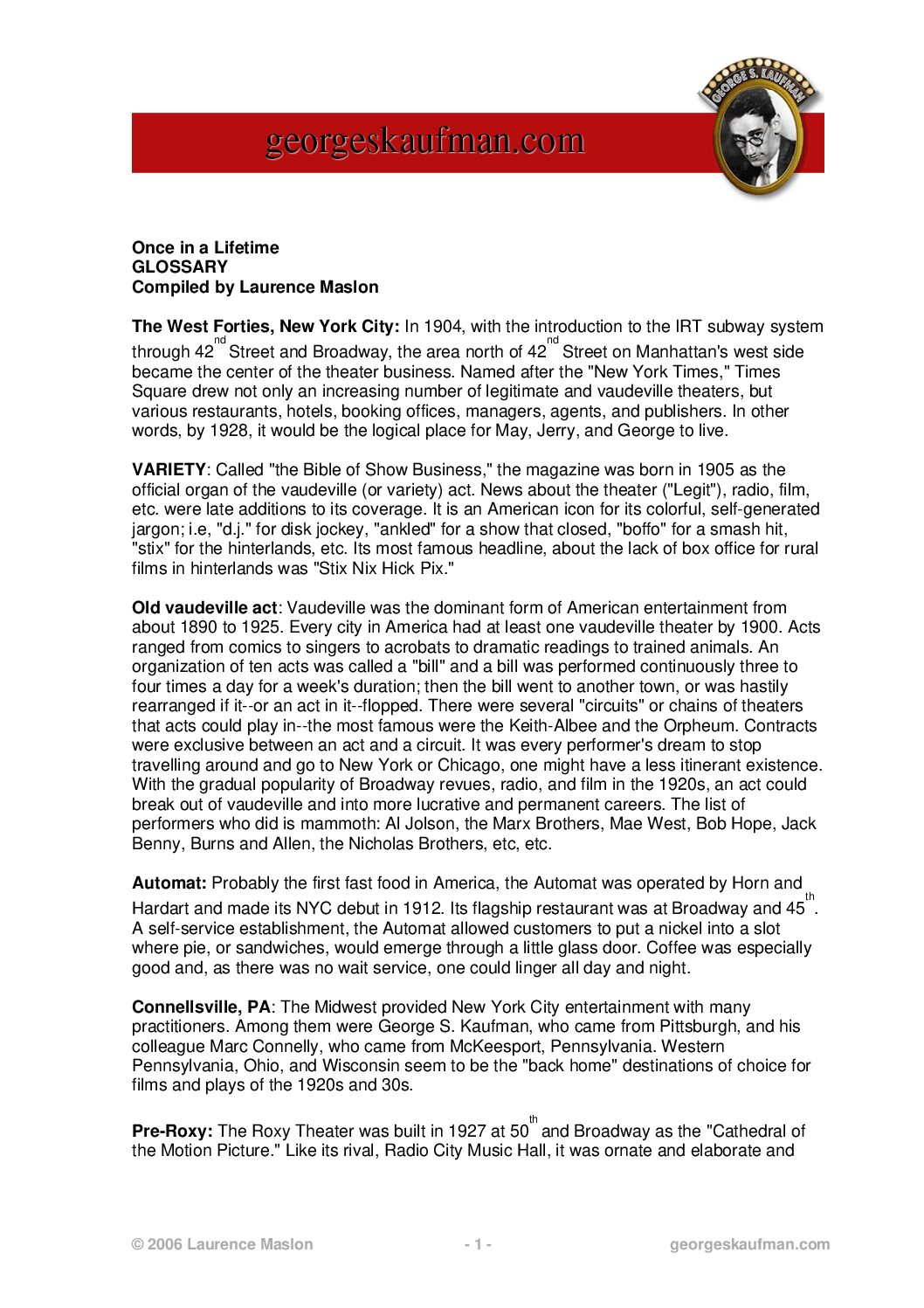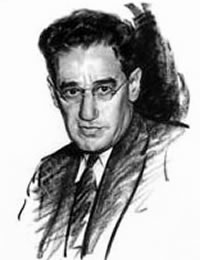The Man Who Came To Dinner: The making of a monster
The Man Who Came To Dinner: The making of a monster
From the George S. Kaufman Archive
The Man Who Came To Dinner: The making of a monster
By Laurence Maslon
If Alexander Woollcott didn’t exist, Kaufman and Hart would have had to invent him. Few personalities bestrode the cultural world between the wars the way that Woolcott did. Broadway critic, book reviewer, radio personality, lecturer, erstwhile actor, gourmand, taste- tester and taste-maker, the corpulent Woollcott wielded an opinion and a rapier-like wit that few could match. With one stroke his enthusiasm could make a smash success, as he did with James Hilton’s novel Good-bye, Mr. Chips, or his deadly disdain could decimate his lesser; reviewing a volume entitled And I Shall Make Music, he wrote, “Not on my carpet, lady!”
Woollcott was also the ringleader of the famed Algonquin Round Table, the collection of writers and raconteurs who shared verbal sortees and luncheon entrees throughout the twenties. Woollcott shared many a lunch with Kaufman and was, in fact, briefly his boss at The New York Times drama desk. Kaufman and Woollcott had even collaborated on two misbegotten plays. But, in the middle of the thirties, Woollcott had caught the acting bug as well. He demanded that Kaufman and his gifted collaborator, Moss Hart, concoct a vehicle for him.
Kaufman and Hart hemmed and hawed for several months. There were several problems; other projects came up and the collaborators were not completely convinced of Woollcott’s ability to hold the stage. Woollcott railed at their indolence in the most obscene ways, but still nothing clicked. But then Hart remembered a time when Woollcott made a surprise visit to Hart’s Bucks County estate. He commandeered Hart’s own bedroom, demanded the heat be turned off and requested a chocolate malted and a chocolate cake. The next morning after loudly excoriating the household staff for incompetency and dishonesty, Woollcott wrote in the guest book: “I wish to say on my first visit to Moss Hart’s house, I had one of the most unpleasant evenings I can ever recall having spent.”
Hart wondered what would have happened if Woollcott had broken his leg on the way out and had to be kept in the house. The proverbial light went on. “This can be a very funny play,” Hart told Kaufman. “All we have to have now are three very funny acts,” replied the gloomy dean of American comedy.
They worked through the spring of 1939, incorporating as many bits of Woollcott’s personality into the character of Sheridan Whiteside as possible. Hart wrote: “In talking about Woollcott, we decided to use only public aspects of his character…his lectures, his broadcasts, his charm, his acidulousness, his interest in murders, and all of this had to be worked into the plot of the play.” The writers included Woollcott’s love of food, celebrities, mad scientists, sob stories, and baby talk for good measure.
Woollcott was, as much as he could be, charmed by the outcome, but balked at playing this version of himself—if it was a hit, it would have taken too much of his time, if a flop, it would have taken too much of his ego. Relieved, the authors bandied about the names of John Barrymore, Adolphe Menjou, and Robert Morley before settling on Monty Woolley, a Yale professor and actor.
When Woolley and the show rolled onto Broadway on October 16, 1939 they became an overnight smash hit and stayed, rather like Whiteside, for a protracted visit of 739 performances. Once its success had been assured, Woollcott became stage-hungry again. The authors agreed that he could star in the second touring company on the West Coast.
Throughout its run there, Woollcott had to suffer on stage the joys and indignities than Kaufman and Hart had heaped upon his persona. But Aleck Woollcott had, typically, the last laugh. After the curtain calls, he would often step down to the footlights and say to the thrilled audience in his nasal, high-pitched, imperious voice: “It’s not true that this role of the obnoxious Sheridan Whiteside was patterned after me. Whiteside is merely a composite of the better qualities of the play’s two authors.”
Laurence Maslon is an associate arts professor at NYU’s Tisch School of the Arts. He is the editor of Kaufman & Co. for the Library of America.
Copyright 2006.
By Laurence Maslon
If Alexander Woollcott didn’t exist, Kaufman and Hart would have had to invent him. Few personalities bestrode the cultural world between the wars the way that Woolcott did. Broadway critic, book reviewer, radio personality, lecturer, erstwhile actor, gourmand, taste- tester and taste-maker, the corpulent Woollcott wielded an opinion and a rapier-like wit that few could match. With one stroke his enthusiasm could make a smash success, as he did with James Hilton’s novel Good-bye, Mr. Chips, or his deadly disdain could decimate his lesser; reviewing a volume entitled And I Shall Make Music, he wrote, “Not on my carpet, lady!”
Woollcott was also the ringleader of the famed Algonquin Round Table, the collection of writers and raconteurs who shared verbal sortees and luncheon entrees throughout the twenties. Woollcott shared many a lunch with Kaufman and was, in fact, briefly his boss at The New York Times drama desk. Kaufman and Woollcott had even collaborated on two misbegotten plays. But, in the middle of the thirties, Woollcott had caught the acting bug as well. He demanded that Kaufman and his gifted collaborator, Moss Hart, concoct a vehicle for him.
Kaufman and Hart hemmed and hawed for several months. There were several problems; other projects came up and the collaborators were not completely convinced of Woollcott’s ability to hold the stage. Woollcott railed at their indolence in the most obscene ways, but still nothing clicked. But then Hart remembered a time when Woollcott made a surprise visit to Hart’s Bucks County estate. He commandeered Hart’s own bedroom, demanded the heat be turned off and requested a chocolate malted and a chocolate cake. The next morning after loudly excoriating the household staff for incompetency and dishonesty, Woollcott wrote in the guest book: “I wish to say on my first visit to Moss Hart’s house, I had one of the most unpleasant evenings I can ever recall having spent.”
Hart wondered what would have happened if Woollcott had broken his leg on the way out and had to be kept in the house. The proverbial light went on. “This can be a very funny play,” Hart told Kaufman. “All we have to have now are three very funny acts,” replied the gloomy dean of American comedy.
They worked through the spring of 1939, incorporating as many bits of Woollcott’s personality into the character of Sheridan Whiteside as possible. Hart wrote: “In talking about Woollcott, we decided to use only public aspects of his character…his lectures, his broadcasts, his charm, his acidulousness, his interest in murders, and all of this had to be worked into the plot of the play.” The writers included Woollcott’s love of food, celebrities, mad scientists, sob stories, and baby talk for good measure.
Woollcott was, as much as he could be, charmed by the outcome, but balked at playing this version of himself—if it was a hit, it would have taken too much of his time, if a flop, it would have taken too much of his ego. Relieved, the authors bandied about the names of John Barrymore, Adolphe Menjou, and Robert Morley before settling on Monty Woolley, a Yale professor and actor.
When Woolley and the show rolled onto Broadway on October 16, 1939 they became an overnight smash hit and stayed, rather like Whiteside, for a protracted visit of 739 performances. Once its success had been assured, Woollcott became stage-hungry again. The authors agreed that he could star in the second touring company on the West Coast.
Throughout its run there, Woollcott had to suffer on stage the joys and indignities than Kaufman and Hart had heaped upon his persona. But Aleck Woollcott had, typically, the last laugh. After the curtain calls, he would often step down to the footlights and say to the thrilled audience in his nasal, high-pitched, imperious voice: “It’s not true that this role of the obnoxious Sheridan Whiteside was patterned after me. Whiteside is merely a composite of the better qualities of the play’s two authors.”
Laurence Maslon is an associate arts professor at NYU’s Tisch School of the Arts. He is the editor of Kaufman & Co. for the Library of America.
Copyright 2006.
More from the
George S. Kaufman Archive
Contact Us Today
Interested in bringing George S. Kaufman’s timeless plays to your stage?
Please refer to the contact information for each specific play on the various collection pages for direct amateur and professional licensing information.
Plays are represented by Concord Theatricals, Broadway Dramatic Licensing, and Music Theatre International respectively
If you are interested in first-class performance or film/television rights:
In the US, George S. Kaufman’s plays are represented by:
CPK Artists, LLC
In the UK, George S. Kaufman’s plays are represented by:
Alan Brodie Representation
For more information about George S. Kaufman or this website, contact:
Laurence Maslon
Literary Trustee, George S. Kaufman Estate

